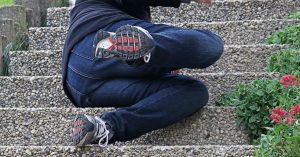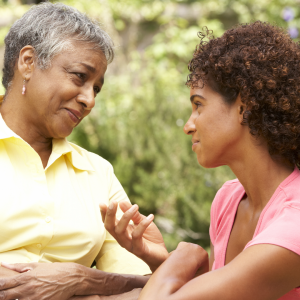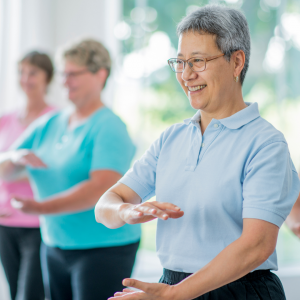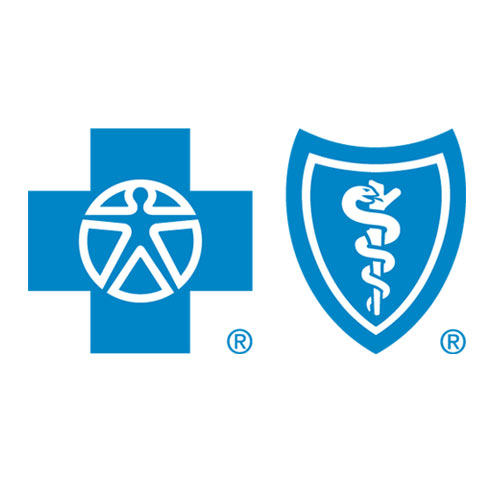How to talk about the risk of falls with the seniors in your life
March 17, 2022As people get older, it becomes more common to fall. It also becomes more dangerous. Every second of every day, an older adult falls, making falls the leading cause of injury for people ages 65 and older. Minnesota’s death rate from falls for this same age group is among the highest in the nation – ranking fourth of all states.
One in five falls causes a serious injury like a broken bone or head injury. (source: CDC)
Luckily, it is possible to reduce the risk of falling. Friends, family members or loved ones may not be aware of their risk or how to avoid falls, so having a conversation about it is more important than you may realize.
We talked to Lori Freit-Hammes, senior program manager at Blue Cross and Blue Shield of Minnesota, to learn more about how best to talk about the topic with the seniors in your life.
What does the data tell us?
 Blue Cross tracks a variety of data sources, including self-reported health risk assessments and state and national statistics. Unfortunately, the data tells us that falls are a real problem.
Blue Cross tracks a variety of data sources, including self-reported health risk assessments and state and national statistics. Unfortunately, the data tells us that falls are a real problem.
Since we know 87 percent of broken bones among seniors ages 65 and older are related to a fall, we also watch claims for fractures. And by watching this data, we noticed that fractures amongst one segment of our Medicare members increased significantly in the past few years, which caused us concern. Blue Cross has a unique role as an extension of our members’ care teams, so we look for ways to help decrease the risk of falling.
Why is a first fall so significant?
An unintentional fall that causes injury, or even a stumble or near-miss, can have a significant negative impact on a person’s physical and psychological well-being. The harsh reality is that many older adults who fall and experience injury simply do not fully recover to their previous level of health and wellness. Having fallen once is the greatest predictor of a future fall.
On top of that, fear of falling is actually a risk factor all by itself and a strong predictor of a future fall. Fear can cause people to change certain behaviors thinking they are keeping themselves safer – restricting activities and avoiding leaving their homes. However, this self-imposed premature immobility can lead to social isolation, mental health declines, the need for additional medications and more. Each change can lead to poorer health, making them even more susceptible to falling.
Why is it important to talk about falling with the seniors in our lives and how do we best approach the conversation?
Concerns about losing independence or being a burden can lead to seniors to be less than forthcoming about a past or recent fall. There is no shame in falling, but a stigma still exists.
 Caregivers, family members and health care professionals can start the conversation to make sure seniors feel seen and their concerns heard. Here are some tips for broaching the conversation:
Caregivers, family members and health care professionals can start the conversation to make sure seniors feel seen and their concerns heard. Here are some tips for broaching the conversation:
- Keep the tone positive and non-judgmental
- Avoid skepticism, blame or minimizing their concerns
- Focus on being a trusted person they can reach out to
- Do a little homework and be educated before the conversation
Here’s an example of how an adult might start the conversation with their older parent:
“Mom, I recently learned that individuals who are worried about falling are more likely to fall. Does this surprise you? If you are worried, it’s okay to feel nervous or anxious. It’s more common than you might believe. I also read that not talking about falls puts people at even greater risk of falling. If you’re comfortable, let’s talk about what, if any, concerns you have. I’m here for you. We can work together to reduce your chances of falling and so you can continue to live independently.”
What is Blue Cross doing to help members at higher risk of falling?
Reducing the risk of falls for our members encompasses screening, awareness, education and also helping our members take appropriate action to make changes.
 We provide education to our members and caregivers in several ways including thrive. magazine, our Caregiver Corner website and more. We also partner with health care systems to ensure providers are screening for fall risks, recommending fall prevention programs and alerting individuals of the action steps they can take to minimize their risk of falling.
We provide education to our members and caregivers in several ways including thrive. magazine, our Caregiver Corner website and more. We also partner with health care systems to ensure providers are screening for fall risks, recommending fall prevention programs and alerting individuals of the action steps they can take to minimize their risk of falling.
Blue Cross Medicare plans offer access to the SilverSneakers fitness program, which has a variety of content and programming for preventing falls including videos, articles and stability classes.
Additional benefits are available for SecureBlue members, including fall prevention classes through Juniper as well as a home safety benefit arranged through their care coordinator to provide up to $750 per year for home safety items such as grab bars, a hand-held shower spray, toilet safety rails, a step support for the bed, etc., to improve mobility and safety in the home.
Blue Cross members can call the number on the back of their ID card to learn about benefits specific to their health plan.


